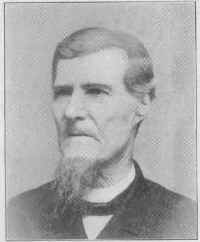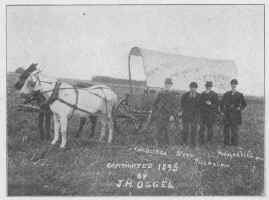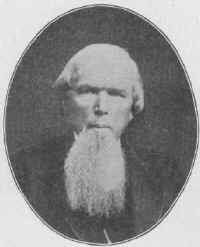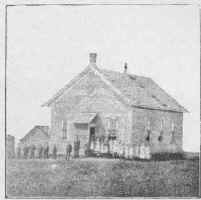|
committee reported, great interest was shown, and the
excitement was great. At that time government land could be bought for
$2.50 per acre every alternate section, the other section belonging to
the railroad company and could be bought when the company built their
road. A motion was made and carried that all who were willing could go
and homestead 80 acres, or pre-empt 160 acres.

H. MUILENBURG
Orange City.
Born in Netherlands, June 21, 1822.
Settled in Sioux County, 1872
It was also then and
there agreed to buy a half section for a town sight, and several men
wanted to buy land for themselves, so a few thousand dollars was
deposited for that purpose and 120 names were given for homesteads, who were
willing to go; then a committee was appointed to buy a town site, and
also buy land for those to purchase. The names of the committee chosen
were Henry Hospers, L. Van der Meer, D. Van den Bos and H. J. Van der
Waa. It was decided that Henry Hospers should go by rail, and the others
by wagon, and the same mule team was taken on the second trip. It was
also decided that the homesteads should be drawn by the committee, and
the head of every family should have his relatives on the same adjoining
section. After arriving at the land office in Sioux City, what a
disappointment it was for us to find that the land for miles west of
Cherokee had been taken by speculators, and they were there to sell to
us at a great profit; we also found that the government had taken their
land out of the market, so no land could be bought for those who wanted
to buy, and the town site fell through. So the next thing to do was to
take a surveyor with us, and go and look at land in Sioux County. When
we came to where Le Mars now is, we found one building, in which Blodget
and Flint had a store; from there to where Seney is now located along
the Floyd river there were few settlers, the Reeves and Mr. Dayton. Soon
after leaving Mr. Dayton's we struck Sioux County, and began the survey
and throwing up high knolls so that we could find our way back; those
knolls served us as land marks the next time, and also the next spring
when we moved our families. After two days we got back to Sioux City,
being satisfied that where Orange City, Sioux Center and Alton now stand
would be the place for the colony: most all the homesteads were taken in
Holland and adjoining townships. The next day the committee secured the
office room of Mr. L. Wynn (our surveyor) and proceeded to select the
homesteads. The committee seated themselves around the table, the number
of the section was put on a slip of paper and placed in a box, then the
names of those who wanted a homestead were written on a separate slop
and put in another box; one of the committee would draw the number of
some section, and then a name would be drawn out of the other box, one
would call off the number of the section while the other would read the
name in this wise: Section 30 was drawn and J. Smith's name was taken
out, so J. Smith's homestead was in the northeast ¼ of section 30 and
he was allowed to name his relatives or friends to take for themselves
land in the same section, and sometimes the question is asked, how is it
that you have taken homesteads and have your relatives around you? We
also named the township Holland. Having done all we could at this time,
we started for home. After arriving in Pella, we called a meeting and
reported what had been done, so the Holland colony would be located in
Sioux County, Holland Township 95-44, but today the settlement covers at
least two thirds of Sioux County. The next meeting was called for the
purpose of having our homesteads, or preemptions surveyed, and some
breaking done in order to hold the same, and comply with the law; about
eighteen or twenty teams went with from four to six men to each team and
Mr. Wynn, our first surveyor. This time surveying and breaking took from
one to two weeks.
Early in spring of 1870, the first train of
five families started for Sioux County, H. J. Van der Waa taking the
lead as he and his team had traveled the road three times: G. Van de
Steeg, Sr., H. J. Luymes, A. Van der Meide and the Beukelman Bros. Old
lady Beukelman and her daughter were the only women that came along, and
were the first women of the colony to settle in Sioux County; Chas.
Draayom married the daughter. The second train was from Sand Ridge;
their leader was J. Pelmulder, one of the committee; this train
consisted of several families, I think all were Frieslanders.

COMMITTEE OF 1869
The third train started from Amsterdam, three
miles south of Pella, leaders L. Van der Meer and D. Van den Bos. There
were from twenty to twenty-five teams and from two to four yoke of oxen
to each wagon. Other trains followed during the spring and summer, all
from Pella and vicinity. I also recollect two families coming all the
way from Chicago: we met them on the road with their teams tired out but
they were helped along by our party; their names were W. De Voss and
Simon De Bruin.
REMINISCENCE OF EARLY DAYS IN SIOUX COUNTY
By A. Van der Meide
Having read the foregoing article written by Mr. H. J.
Van der Waa, I do not think it out of place to add a few incidents to
it, since we were with him on his trip to Sioux County in 1870, he being
considered our leader, as he had been over the road before.
At the start of our trip he showed poor generalship, as it was only the
second day, I think, that he led us onto a bridge in Polk County that
proves my assertion as to his generalship. Five teams were in our party:
H. J. Van der Waa, G. Van de Steeg, Sr., who died some time ago, and his
three sons - John Van de Steeg, who is now a merchant in Orange City, G.
L. Van de Steeg, postmaster at present in Orange City, and Gerrit Van de
Steeg, who was recently killed in a railroad accident in Minnesota, H.
J. Luymes and his three sons - Robert, Johannes and Teunis; Robert and
Johannes having died some time ago and Teunis at present janitor in our
Sioux County Courthouse, Arie Beukelman and his mother and only sister,
all of whom have passed away from this earth, and the writer, making the
fifth team. As stated before, we were led on the bridge following Mr.
Van der Waa as closely as we could. Crossing it in a zig zag way, four
teams managed to get over it in safety. The fifth team belonging to A.
Beukelman, his mother and sister, they not being accustomed to driving
horses, having been in the country but a little over a year, did not
fare so well. He had three horses with him, two hitched to his wagon and
one led on behind, and between them they had only one eye they could see
with. The result was that he did not keep the same track the others had
done but intended to drive straight across the bridge, and the flooring
being loose, having worked to the north by traveling over it, tipped and
the whole outfit came down twelve feed in the creek, horses and all,
where there was about two feet of water.

REV. S. BOLKS, Deceased
Born in Netherlands, April 30th, 1814.
Settled in Sioux County, 1872
Died June 16th, 1894
It did not take us very long to
hitch our teams and go to their rescue, expecting to find some of them
dead under the heavy load they had, but we were happily surprised when
we go to them to find that the old lady and her daughter had fallen
outside of the wagon and Mr. Beukelman was held on the wagon box with
his legs, receiving only slight bruises, and the others not as much as a
scratch. The only death loss was the chickens that were drowned before
we got to them. This was in the forenoon of the second day of our trip,
so we stopped for the day to make repairs to the wagon and to dry the
goods which they had with them by spreading the same out on quilts and
blankets on the grass, and the old lady was kept busy drying the few
greenbacks she had with her. By the following morning, all was repaired
again so that we could go on with our journey, and by so doing Polk
County was saved several thousand dollars for damages.
After the accident we must say that we never
had a better leader and general than Mr. Van der Waa. From then on we
moved along slowly as the roads were bad and there was a great deal of
swampy country to pass through and we did not venture on any more
bridges without examining them before we undertook to cross them so that
we were sure they were safe.

FIRST SCHOOL HOUSE, ORANGE CITY
We preferred to get stalled rather than to
have a fall. It took us nineteen days to make the trip of about two
hundred and fifty miles, and hard work at that, as I well remember that
there was one day when we only made three miles, and working from
daylight to sundown, by loading and unloading our loads, and in crossing
sloughs and swamps. But it did not affect us as it did the Israelites of
old, as we did not murmur or care to go back home. We had faith in what
our leader said: "There is no fairer country or better land under
the sun than Sioux County," and correct he was, having finally
arrived in Sioux County it proved to us that his statement was true.
The first night we reached Sioux County, we
camped on what is now called "The Orange City Slough,"
three-fourths of a mile north of Orange City. The next morning we
started out to look up our lands, going as we thought, with our map in
our hands, northward and northwest, following as near as we could the
section lines. After having traveled all day and when the sun was fast
sinking away in the west, we started for camp, thinking we had seen most
of our claims and being well satisfied with the same. Having gone but a
short distance towards our camp as we thought, we noticed someone with
some horses to the west of us who were grazing along a slough. Of course
we wished to know who else was in Sioux County except our party, and
going to where he was we found it to be one of our own party whom we had
left with our horses and wagon, and we were not a little surprised to
find out that we had been going southeast and south all day instead of
north and northwest. If it had not been for meeting him we do not know
where we soul have landed; probably we would still be going south and
would never have reached our camp. After having been here a few days, a
good many more colonists arrived and we all got busy breaking prairie
and raising a crop the following year. The winter was mild and there was
no snow so that in early spring we commenced our work by putting in our
grain and we raised a very good crop. By fall we had to have sheds,
cribs, etc., so most of us went to Rock River to get some wood, there
being some timber along said river. Of course it all belonged to the
government or Uncle Sam, as we supposed, but there were a few settlers
on the Rock by this time who thought and claimed different and claimed
to be the owners of some of the lands. The result was that some of our
people were driven away with pitchforks and others were cut down with
axes and laid up for several weeks but no one was fatally hurt. The
hauling of timber continued just the same. The meanest thing that was
done by these people claiming the land was this: they would take fire
wood from some of the piles that were prepared by the settlers, make a
hole in it with an auger, place a certain quantity of powder in it, and
plug the hole with a wooden plug and then place it back again in the
pile so that it could not be detected, in order to be exploded in the
cook stove, which happened several times.
During this winter, the courthouse war started
which lasted for almost thirty years, off and on. The county seat was at
Calliope at the time we came here, and at our first election, Tjeerd
Heemstra was elected as member of the Board of Supervisors from our
district and served one year. Henry Hospers was elected the second year
to fill his place and J. W. Greatrax as treasurer and A. J. Betten, Jr.
as Auditor. On January 1, 1872, Henry Hospers took the oath of office
and was seated with the Board of Supervisors, but when it cam to
approving the bonds of Mr. Greatrax and Mr. Betten, the Board refused to
approve the same: Hospers voting to accept and the other to reject,
claiming that the bonds were illegal, not duly signed, amount not
sufficient and various other reasons, all in order to keep them out of
office. They undoubtedly saw that it was the beginning of the end of
their career as office holders of Sioux County which had been very
profitable to them as the county had a good many bonds...
Continued on Page 3
|